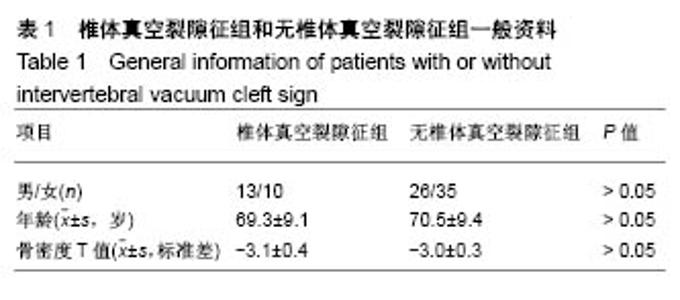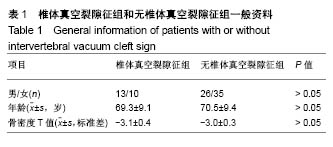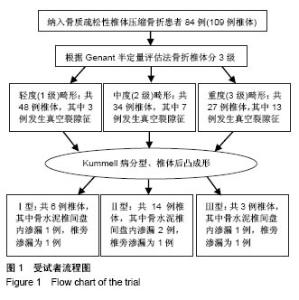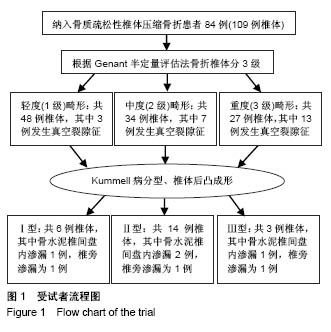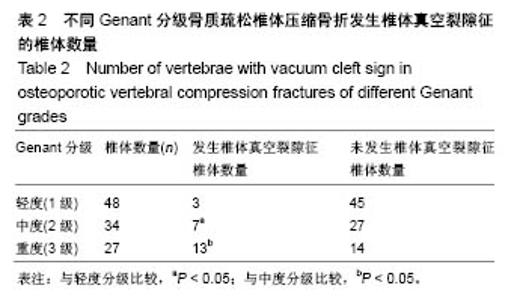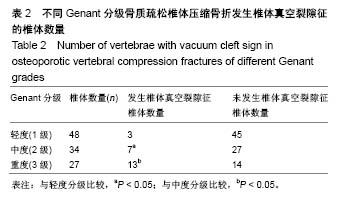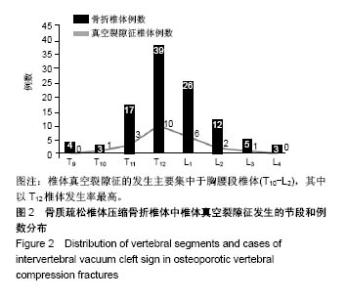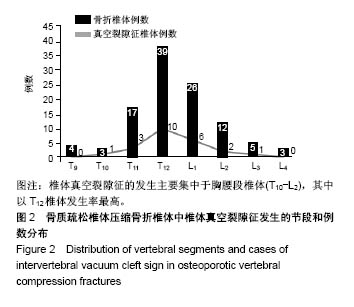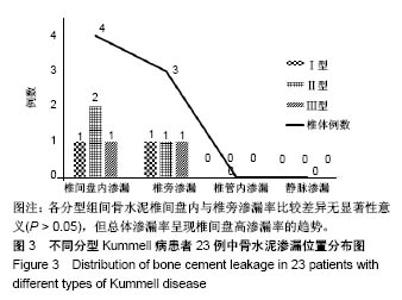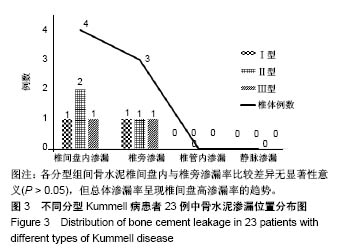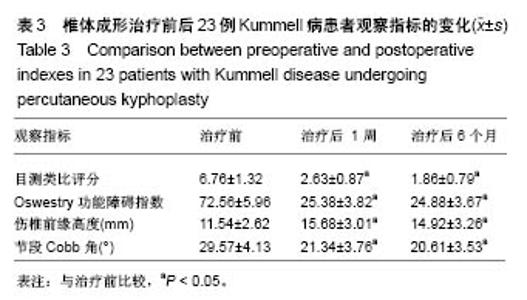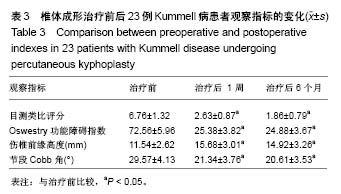Chinese Journal of Tissue Engineering Research ›› 2019, Vol. 23 ›› Issue (2): 172-177.doi: 10.3969/j.issn.2095-4344.0691
Previous Articles Next Articles
Kummell disease: bone cement leakage during kyphoplasty
Lu Wenchao, Wang Yupeng, Zhan Chuan
- Department of Orthopedics, the Fourth Affiliated Hospital of China Medical University, Shenyang 110032, Liaoning Province, China
-
Received:2018-07-29Online:2019-01-18Published:2019-01-18 -
Contact:Zhan Chuan, Professor, Chief physician, Department of Orthopedics, the Fourth Affiliated Hospital of China Medical University, Shenyang 110032, Liaoning Province, China -
About author:Lu Wenchao, Master candidate, Department of Orthopedics, the Fourth Affiliated Hospital of China Medical University, Shenyang 110032, Liaoning Province, China
CLC Number:
Cite this article
Lu Wenchao, Wang Yupeng, Zhan Chuan. Kummell disease: bone cement leakage during kyphoplasty[J]. Chinese Journal of Tissue Engineering Research, 2019, 23(2): 172-177.
share this article
Add to citation manager EndNote|Reference Manager|ProCite|BibTeX|RefWorks
| [1] Ranjan M,Mahadevan A,Prasad C,et al.Kummell's disease - uncommon or underreported disease: A clinicopathological account of a case and review of literature.J Neurosci Rural Pract.2013;4(4): 439-442.[2] Nickell LT,Schucany WG,Opatowsky MJ.Kummell disease. Proc (Bayl Univ Med Cent).2013;26(3): 300-301.[3] Lim J,Choi SW,Youm JY,et al. Posttraumatic Delayed Vertebral Collapse : Kummell's Disease. J Korean Neurosurg Soc. 2018;61(1): 1-9.[4] Kim H,Jun S,Park SK,et al.Intravertebral vacuum cleft sign: a cause of vertebral cold defect on bone scan.Skeletal Radiol. 2016;45(5): 707-712.[5] Zha LL,Tong PJ,Xia LW,et al.Diagnostic analysis of the radiologic characteristics in osteoporotic Kiinmmel's disease. Zhongguo Gu Shang.2016;29(5):460-463.[6] Yu W, Jiang X,Liang, et al.Intravertebral Vacuum Cleft and Its Varied Locations within Osteoporotic Vertebral Compression Fractures: Effect on Therapeutic Efficacy.Pain Physician. 2017;20(6): E979-E986.[7] Yang H,Liu H,Wang S,et al.Review of Percutaneous Kyphoplasty in China.Spine(Phila Pa 1976). 2016;41 Suppl 19:B52-B58.[8] Matzaroglou C,Georgiou CS,Panagopoulos A,et al.Kummell's Disease: Clarifying the Mechanisms and Patients' Inclusion Criteria. Open Orthop J.2014;8:288-297.[9] Libicher M,Appelt A,Berger I,et al.The intravertebral vacuum phenomen as specific sign of osteonecrosis in vertebral compression fractures: results from a radiological and histological study. Eur Radiol. 2007;17(9):2248-2252.[10] 李良辰,何登伟,黄文君,等.Kummell病椎体裂隙征发生机制的研究进展[J].中华骨质疏松和骨矿盐疾病杂志,2015,8(4):363-366.[11] 钟远鸣,李兵,李智斐,等.骨质疏松性椎体骨折椎体形态与Kummell病的相关性[J].实用医学杂志,2015, 31(22):3661-3662.[12] Tsujio T,Nakamura H,Terai H,et al.Characteristic radiographic or magnetic resonance images of fresh osteoporotic vertebral fractures predicting potential risk for nonunion: a prospective multicenter study. Spine(Phila Pa 1976). 2011;36(15):1229-1235.[13] Muratore M,Ferrera A,Masse A,et al.Osteoporotic vertebral fractures: predictive factors for conservative treatment failure.A systematic review.Eur Spine J.2017. doi: 10.1007/s00586-017-5340-z. [Epub ahead of print][14] Kanchiku T,Imajo Y,Suzuki H,et al.Usefulness of an early MRI-based classification system for predicting vertebral collapse and pseudoarthrosis after osteoporotic vertebral fractures.J Spinal Disord Tech.2014;27(2):E61-65.[15] Tome-Bermejo F,Pinera AR,Duran-Alvarez C,et al. Identification of Risk Factors for the Occurrence of Cement Leakage During Percutaneous Vertebroplasty for Painful Osteoporotic or Malignant Vertebral Fracture.Spine(Phila Pa 1976).2014;39(11):E693-E700.[16] Formica M,Basso M,Cavagnaro L,et al.Kummell disease: illustrative case for definition criteria. Spine J. 2016;16(10):e707-e708.[17] Genant HK.Assessment of vertebral fractures in osteoporosis research.J Rheumatol.1997;24(6):1212-1214.[18] Li KC,Wong TU,Kung FC.Staging of Kümmell's disease.J Musculoskel Res.2004;8(1):43-55.[19] Kummell H.Die rarefizierende ostitis der wirbelkorper. Deutsche Med. 1895;21:180-181.[20] Ma R,Chow R,Shen FH.Kummell's disease: delayed post-traumatic osteonecrosis of the vertebral body.Eur Spine J. 2010;19(7): 1065-1070.[21] Young WF,Brown D,Kendler A,et al.Delayed post-traumatic osteonecrosis of a vertebral body (Kummell's disease).Acta Orthop Belg.2002;68(1):13-19.[22] 张磊磊,李健.Kummell病的研究进展[J].中国矫形外科杂志, 2015,23(9): 816-819.[23] van der Schaaf I,Fransen H.Percutaneous vertebroplasty as treatment for Kummell's disease. JBR-BTR. 2009;92(2):83-85.[24] Marie PJ,Kassem M.Osteoblasts in osteoporosis: past, emerging, and future anabolic targets.Eur J Endocrinol. 2011;165(1):1-10.[25] Matzaroglou C,Georgiou CS,Assimakopoulos K,et al.Kummell's disease: pathophysiology, diagnosis, treatment and the role of nuclear medicine. Rationale according to our experience.Hell J Nucl Med. 2011;14(3):291-299.[26] Wu AM,Chi YL,Ni WF.Vertebral compression fracture with intravertebral vacuum cleft sign: pathogenesis, image, and surgical intervention.Asian Spine J.2013;7(2):148-155.[27] He D,Yu W,Chen Z,et al. Pathogenesis of the intravertebral vacuum of Kummell's disease.Exp Ther Med. 2016;12(2):879-882.[28] Laredo JD.Expert's comment concerning Grand Rounds case entitled "Kümmell's disease: delayed post-traumatic osteonecrosis of the vertebral body" (by R. Ma, R. Chow, F. H. Shen). Eur Spine J.2010; 19(7):1071-1072.[29] Matzaroglou C,Georgiou CS,Assimakopoulos K,et al. Kummell' s disease: A rare spine entity in a young adult.Hell J Nucl Med. 2010; 13(1):52-55.[30] Baba H,Maezawa Y,Kamitani K,et al.Osteoporotic vertebral collapse with late neurological complications. Paraplegia. 1995;33(5):281-289.[31] Wang Q,Wang C,Fan S,et al.Pathomechanism of intravertebral clefts in osteoporotic compression fractures of the spine: basivertebral foramen collapse might cause intravertebral avascular necrosis. Spine J. 2014;14(6):1090-1091.[32] Wang H,Sribastav SS,Ye F,et al.Comparison of Percutaneous Vertebroplasty and Balloon Kyphoplasty for the Treatment of Single Level Vertebral Compression Fractures: A Meta-analysis of the Literature.Pain Physician. 2015;18(3):209-222.[33] Zhang H,Xu C,Zhang T,et al.Does Percutaneous Vertebroplasty or Balloon Kyphoplasty for Osteoporotic Vertebral Compression Fractures Increase the Incidence of New Vertebral Fractures? A Meta-Analysis.Pain Physician. 2017;20(1):E13-E28.[34] 杨惠林.科学认识椎体成形术与椎体后凸成形术的临床价值[J].中国脊柱脊髓杂志,2010,20(6):441-443.[35] McConnell CT Jr,Wippold FJ 2nd,Ray CE Jr,et al.ACR appropriateness criteria management of vertebral compress fratures.J Am Coll Radiol.2014;11(8):757-763. [36] Kim YC,Kim YH,Ha KY.Pathomechanism of intravertebral clefts in osteoporotic compression fractures of the spine. Spine J. 2014;14(4): 659-666. [37] Ren H,Wang J,Chen J,et al.Clinical efficacy of unipedicular versus bipedicular percutaneous vertebroplasty for Kummell's disease.J South Med Univ.2014;34(9):1370-1374. [38] Venmans A,Klazen CA,van Rooij WJ,et al.Postprocedural CT for perivertebral cement leakage in percutaneous vertebroplasty is not necessary--results from VERTOS II. Neuroradiology.2011;53(1):19-22.[39] Saracen A,Kotwica Z.Complications of percutaneous vertebroplasty: An analysis of 1100 procedures performed in 616 patients. Medicine. 2016;95(24):e3850.[40] Yang H,Gan M,Zou J,et al.Kyphoplasty for the treatment of Kümmell's disease. Orthopedics.2010; 33(7):479.[41] Ha KY,Lee JS,Kim KW,et al.Percutaneous vertebroplasty for vertebral compression fractures with and without intravertebral clefts.J Bone Joint Surg Br.2006;88:629-633.[42] Kong LD,Wang P,Wang LF,et al.Comparison of vertebroplasty and kyphoplasty in the treatment of osteoporoticvertebral compression fractures with intravertebral clefts.Eur J Orthop Surg Traumatol. 2014; 24(Suppl 1):S201-208. [43] Tanigawa N,Kariya S,Komemushi A,et al.Cement leakage in percutaneous vertebroplasty for osteoporotic compression fractures with or without intravertebral clefts.AJR Am J Roentgenol. 2009;193: W442-445. [44] Komemushi A,Tanigawa N,Kariya S,et al.Percutaneous vertebroplasty for osteoporotic compression fracture: multivariate study of predictors of new vertebral body fracture.Cardiovasc Intervent Radiol. 2006;29: 580-585.[45] Kim YJ,Lee JW,Park KW,et al.Pulmonary cement embolism after percutaneous vertebroplasty in osteoporotic vertebral compression fractures: incidence, characteristics, and risk factors.Radiology. 2009; 251:250-259.[46] Ren H,Shen Y,Zhang YZ,et al.Correlative factor analysis on the complications resulting from cement leakage after percutaneous kyphoplasty in the treatment of osteoporotic vertebral compression fracture. J Spinal Disord Tech. 2010;23:e9-15. [47] Chen L,Dong R,Gu Y,et al.Comparison between Balloon Kyphoplasty and Short Segmental Fixation Combined with Vertebroplasty in the Treatment of Kümmell's Disease.Pain Physician.2015;18(4):373-381.[48] Zhang ZF,Yang JL,Jiang HC,et al.An updated comparison of high- and low-viscosity cement vertebroplasty in the treatment of osteoporotic thoracolumbar vertebral compression fractures: A retrospective cohort study.Int J Surg. 2017;43:126-130.[49] Wu AM,Li XL,Li XB,et al.The outcomes of percutaneous kyphoplasty in treatment of the secondary osteoporotic vertebral compression factures: a case-control study.Ann Transl Med.2018;6(6):107. |
| [1] | Zhang Tongtong, Wang Zhonghua, Wen Jie, Song Yuxin, Liu Lin. Application of three-dimensional printing model in surgical resection and reconstruction of cervical tumor [J]. Chinese Journal of Tissue Engineering Research, 2021, 25(9): 1335-1339. |
| [2] | Tang Hui, Yao Zhihao, Luo Daowen, Peng Shuanglin, Yang Shuanglin, Wang Lang, Xiao Jingang. High fat and high sugar diet combined with streptozotocin to establish a rat model of type 2 diabetic osteoporosis [J]. Chinese Journal of Tissue Engineering Research, 2021, 25(8): 1207-1211. |
| [3] | Li Zhongfeng, Chen Minghai, Fan Yinuo, Wei Qiushi, He Wei, Chen Zhenqiu. Mechanism of Yougui Yin for steroid-induced femoral head necrosis based on network pharmacology [J]. Chinese Journal of Tissue Engineering Research, 2021, 25(8): 1256-1263. |
| [4] | Zeng Yanhua, Hao Yanlei. In vitro culture and purification of Schwann cells: a systematic review [J]. Chinese Journal of Tissue Engineering Research, 2021, 25(7): 1135-1141. |
| [5] | Hou Guangyuan, Zhang Jixue, Zhang Zhijun, Meng Xianghui, Duan Wen, Gao Weilu. Bone cement pedicle screw fixation and fusion in the treatment of degenerative spinal disease with osteoporosis: one-year follow-up [J]. Chinese Journal of Tissue Engineering Research, 2021, 25(6): 878-883. |
| [6] | Li Shibin, Lai Yu, Zhou Yi, Liao Jianzhao, Zhang Xiaoyun, Zhang Xuan. Pathogenesis of hormonal osteonecrosis of the femoral head and the target effect of related signaling pathways [J]. Chinese Journal of Tissue Engineering Research, 2021, 25(6): 935-941. |
| [7] | Xiao Fangjun, Chen Shudong, Luan Jiyao, Hou Yu, He Kun, Lin Dingkun. An insight into the mechanism of Salvia miltiorrhiza intervention on osteoporosis based on network pharmacology [J]. Chinese Journal of Tissue Engineering Research, 2021, 25(5): 772-778. |
| [8] | Liu Bo, Chen Xianghe, Yang Kang, Yu Huilin, Lu Pengcheng. Mechanism of DNA methylation in exercise intervention for osteoporosis [J]. Chinese Journal of Tissue Engineering Research, 2021, 25(5): 791-797. |
| [9] | Xu Dongzi, Zhang Ting, Ouyang Zhaolian. The global competitive situation of cardiac tissue engineering based on patent analysis [J]. Chinese Journal of Tissue Engineering Research, 2021, 25(5): 807-812. |
| [10] | Wu Zijian, Hu Zhaoduan, Xie Youqiong, Wang Feng, Li Jia, Li Bocun, Cai Guowei, Peng Rui. Three-dimensional printing technology and bone tissue engineering research: literature metrology and visual analysis of research hotspots [J]. Chinese Journal of Tissue Engineering Research, 2021, 25(4): 564-569. |
| [11] | Chang Wenliao, Zhao Jie, Sun Xiaoliang, Wang Kun, Wu Guofeng, Zhou Jian, Li Shuxiang, Sun Han. Material selection, theoretical design and biomimetic function of artificial periosteum [J]. Chinese Journal of Tissue Engineering Research, 2021, 25(4): 600-606. |
| [12] | Liu Fei, Cui Yutao, Liu He. Advantages and problems of local antibiotic delivery system in the treatment of osteomyelitis [J]. Chinese Journal of Tissue Engineering Research, 2021, 25(4): 614-620. |
| [13] | Li Xiaozhuang, Duan Hao, Wang Weizhou, Tang Zhihong, Wang Yanghao, He Fei. Application of bone tissue engineering materials in the treatment of bone defect diseases in vivo [J]. Chinese Journal of Tissue Engineering Research, 2021, 25(4): 626-631. |
| [14] | Zhang Zhenkun, Li Zhe, Li Ya, Wang Yingying, Wang Yaping, Zhou Xinkui, Ma Shanshan, Guan Fangxia. Application of alginate based hydrogels/dressings in wound healing: sustained, dynamic and sequential release [J]. Chinese Journal of Tissue Engineering Research, 2021, 25(4): 638-643. |
| [15] | Chen Jiana, Qiu Yanling, Nie Minhai, Liu Xuqian. Tissue engineering scaffolds in repairing oral and maxillofacial soft tissue defects [J]. Chinese Journal of Tissue Engineering Research, 2021, 25(4): 644-650. |
| Viewed | ||||||
|
Full text |
|
|||||
|
Abstract |
|
|||||
